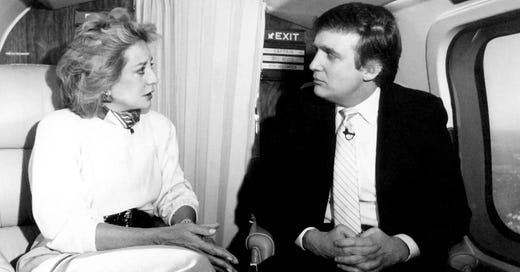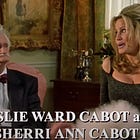Barbara Walters, Trump, and the Art of Asking Questions to Connect
Tips in relationship-building from some wise journalists.
Some people just have a way of making others open up. Barbara Walters was one of them. But it wasn’t charm or flattery that made her interviews legendary—it was something much simpler. And something we can all learn to use.
I first became fascinated by the way journalists build connections when I went on a deep dive into Walters’ history. She wasn’t just a groundbreaking broadcaster—she was a bridge-builder, creating space for some of the most guarded and powerful figures in the world to let their walls down. And she not only connected with prickly celebrities like Barbra Streisand, she also found her way to get politicians like Fidel Castro to open up. Amazingly, she even connected with Egyptian President Anwar Sadat and Israeli Prime Minister Menachem Begin and connected them to each other through their connection to her.
Naturally, it got me thinking… How does a journalist like Walters create the kind of trust with the people they interview that makes individuals feel safe enough to open up—even about extremely touchy topics?
And, I wondered, how much do the skills journalists use parallel how therapists do their work?
Journalists and therapists have distinct objectives. Journalists work to communicate stories and information to their audience. Therapists help patients overcome psychological problems. Yet both of these professions share something important: building a connection—sometimes with a less-than-willing participant. Building those connections is critical to professional success.
Connection is something all humans need, there is no doubt of this. But sometimes we don’t know how to build it. By looking to the pros, we can find some key takeaway lessons that we can each apply in our own relational lives.
The Brilliance of Barbara Walters, Circa 1990
With a career spanning more than six decades, Barbara Walters not only broke ground as the first woman to hold a co-host position on an American news program, she was and remains famous for her unparalleled ability to connect.
Examining old footage of Walters, I stumbled upon a 1990 interview Walters did with a rather youthful-looking Donald Trump. The interview timing was around the release of Surviving at the Top (a follow-up to Trump’s much better-known The Art of the Deal). Walters didn’t only want to discuss the new book, she wanted to talk about Trump’s bankruptcy and his very public and contentious divorce from Ivanka Trump and barely-hidden affair with Marla Maples. Trump likely knew this and, for the most part, looks about as happy to participate as a partner being dragged to couples’ therapy.1
Nevertheless, Walters launches in with this first question:
The new book is entitled Surviving at the Top. [But ] there are many people who would say “failing at the top.
Trump counters by blaming the journalists for this conclusion. He states:
I hope the public understands how inherently dishonest the press in this country is.2
Walters doesn’t back down. As “a member of the press,” she invites Trump to help her clear things up. They have a several minute long back-and-forth about the facts of Trump’s financial status before Walters turns to discuss his failing marriage to Ivanka and the public’s view of his arrogance.
Trump remains persistently guarded, admitting to Walters that he has learned to stay self-protective in the public eye. Walters tells him, “I can understand that.”
It’s at this moment—right after Trump’s admission of his guardedness and Walters validation of it—that Walters seems to see an opening for a more authentic connection. She seizes it, asking Trump about the impact the death of his brother had. And then she asks Trump about where he sees himself going, and where he sees himself today. In this final self-reflection, Trump doesn’t break down in tears, but he does show a rare moment of vulnerability. He admits:
Today’s not great. I mean, between a marriage and between all the struggles and between life and everything else, I mean it’s not like it’s the greatest time in my life.
There is something touching about this moment. It’s a fleeting glimpse into a human who typically shows up as impenetrable. It’s evidence of a hard-won connection between Trump and Walters.
And it took the skills of a top-notch journalist to achieve it.
The Connecting Power of Curiosity
What was it that Walters did to achieve connection with a less-than-receptive- Trump? It wasn’t gentleness, agreement, or validation, the qualities we often assume give rise to connection with prickly people. Rather, it seemed to hinge on her deep, respectful curiosity about him.
Walters was genuinely interested in what made Trump tick, what he believed, where he saw himself going, and what he cared about. She conveyed a deep, authentic, thoughtful curiosity about the man behind the bravado.
This level of respectful, but not pandering, curiosity is inherent in the practice of therapy, too. Authentic curiosity about what a patient is thinking, feeling, and yearning for forms the crux of most therapeutic approaches. Asking probing questions leads to greater feelings of closeness, as one classic study showed because people who ask more questions are more likely to elicit greater levels of disclosure, leading to greater feelings of closeness.
Interviewing the interviewers.
I am not a journalist, but I do know some amazing ones. So, when I started reflecting on the similarities between journalistic relationship-building and therapeutic alliance-building, I asked two of the most thoughtful journalists I know if I could pick their brains on this topic.3
Award-winning science journalist and author of three terrific books (The Expectation Effect, The Intelligence Trap, and The Laws of Connection), David Robson, explained to me,
Great journalists have a drive to learn and understand that pushes them to look beneath the surface of the topic at hand and build a fuller portrait of the people they are interviewing… This fosters connection because it appeals to people’s inherent need to be heard and understood. If they trust that your interest is genuine, they become less defensive and readier to open up.
Being curious conveys a level of respect and care that helps people drop their defenses. As award-winning science journalist, regular New York Times contributor, and author of the best titled-parenting book of all time, How to Raise Kids Who Aren’t Assholes (and one coming out in May: Hello, Cruel World!), Melinda Wenner Moyer told me, she views her thorough preparation for interviews as a way to convey that genuine curiosity. She explained:
It’s another way of indicating that I care about the story and that I respect their time and expertise.
Therapists do something similar in working with clients, demonstrating their curiosity through attention to moment-to-moment emotional shifts and body language in session, story content, and by setting session agendas thoughtfully.
Does Curiosity Need to Be Kind?
You might assume that connection-building curiosity requires heavy doses of kindness and empathy. But it’s a bit more complicated than that.
Take the use of irreverence in an evidence-backed treatment for emotion dysregulation called Dialectical Behavior Therapy (DBT). Irreverence is thought to foster a stronger alliance between client and therapist, and even to enhance a client’s ability to tolerate distress and motivation for change. The classic DBT example of irreverence is when a client shares that they might kill themselves and the therapist responds, “I thought we agreed you weren’t going to quit therapy.”
But for irreverence to be helpful, there needs to be a high level of safety and supportiveness already established. According to DBT founder, Marsha Linehan, irreverence must “come from a place of compassion and warmth toward the client” even though the content of an irreverent statement is intended to put the client off-balance using humor, confrontation, calling a client’s bluff.
You can see this kind of irreverence in many of Walters’ interviews. Many of her best-known interviews have moments of her pressing hard on her interviewees, sometimes pointing out their flaws, asking them to own up the bad behavior, explain their worst traits, admit their shame or regret. She tells Sean Connery:
I swore, when I was preparing the questions for this interview, that I would not use the phrase male chauvinist, but you are a male chauvinist, aren’t you?
And she asks Barbra Streisand:
Why didn’t you have your nose fixed? Everybody must have said to you have your nose fixed.
Yet, it’s usually clear that Walters respects, even cares about, the people she’s interviewing. She often finds a way to compliment them, finishing her 1990 interview with Trump by calling him “disarming.”
As Robson puts it, a journalist might strongly agree with a source’s actions or opinions but will
probably get more revealing answers if they’re genuinely trying to understand the subject of the interview in all their complexity, compared to someone who is less curious in the person.
It’s a deep respect combined with curiosity that fosters the connection.
That combination requires attention to how the other person is feeling. As Wenner Moyer told me,
I am constantly taking in a source’s tone and body language to gauge how they feel, and then responding in ways to try to put them at ease… The last thing you want to be is pushy and make your sources feel they don’t have agency—that’s when they clam up.”
As Walters writes in her 1974 book, How to Talk with Practically Anybody About Practically Anything:
A conversation, even a brief one, should have all the best features of any functioning human relationship, and that means genuine interest on both sides, opportunity and respect for both to express themselves, and some dashes of tact and perception.”
Curiosity conveyed in respectful ways and in a context of safety is one of the most useful building blocks for connection. As Dean Nelson, a journalism program director writes in his book, Talk to Me:
Good interviewers give others the opportunity to give voice to what they observe, experience, ponder, question, help us understand ourselves and others because they draw out these dimensions.
Good interviewers are deeply, respectfully, and sometimes even irreverently, curious. And deep curiosity turns out to be deeply connecting.
How can you use curiosity to strengthen your relationships? Try it today: ask someone a question that goes beyond small talk—something that invites them to share what they think, feel, or want. You might be surprised at what you learn.
This post is free to all, so please share it and/or hit the like button!
Related Reading…
Needless to say, as a couples’ therapist I’ve seen many an unhappy partner enter into the couples’ therapy room. But I’d also like to assure any curious readers that most of the time, it takes just a session or two for the more hesitant partner to get into the groove and see the value in being there.
Impressive how consistent Trump has been about this complaint!
Both journalsits I interviewed for this, David Robson and Melinda Wenner Moyer, have Substacks that I adore: 60 Second Psychology (from David), and Now What (from Melinda). Highly recommend!







beautiful, love this,
Journalist Simi Garewal also have this deep quality,
https://www.youtube.com/watch?v=yZOar04g4zk
It so often comes down to curiosity. Great article, Yael.